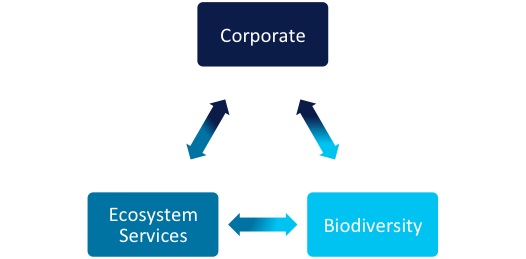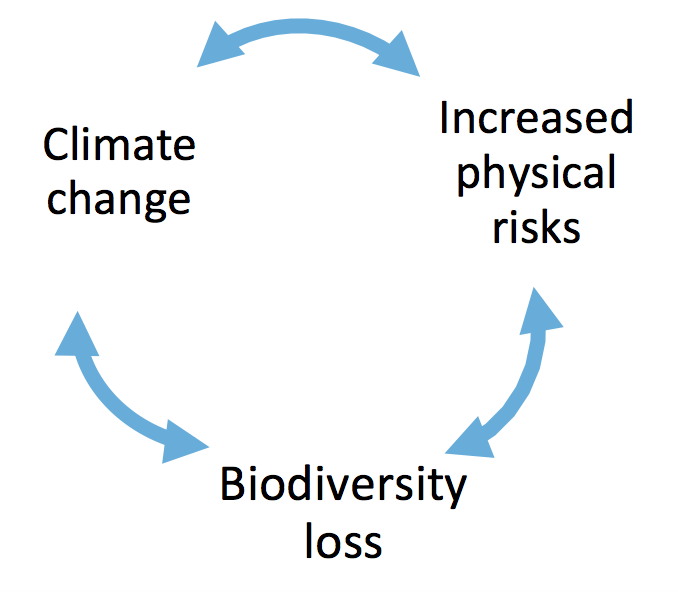What comes to mind when you think of biodiversity loss? A continuous stream of news will often highlight tragedies such as coral bleaching or forest fires in the Amazon but for many, the tangible impacts of biodiversity loss may have only been felt recently with Covid-19.
The biodiversity crisis is considered a major factor in the emergence of zoonotic diseases such as Covid-19, SARS and Ebola (meaning diseases that are transferred from animals to humans). The World Economic Forum has estimated the cost of Covid-19 to be potentially over USD $20 trillion, and according to the OECD protecting biodiversity will be vital to avoid the next pandemic. However, the impact of biodiversity loss is much greater than pandemics alone. Biodiversity provides economic and social value such as food, building materials, clean air, and fresh water with the World Wildlife Fund (WWF) estimating the monetary value of biodiversity around USD $125 trillion a year.
Humans both depend on and impact biodiversity
We rely on biodiversity in three different ways[1]:
First, biodiversity provides ecosystem services such as climate regulation, carbon sequestration, water purification, pollination, and habitat provision. For example, 75% of global food crops rely on animal pollination[2] and an estimated USD $235-$577 billion of annual value of global crop output is at risk due to pollinator loss. Furthermore, marine and terrestrial ecosystems are carbon sinks for anthropogenic emissions with global gross sequestration around 5.6 gig tons of carbon per year (equivalent to 60% of global anthropogenic emissions).[2] Mangrove forests are also a natural defense for flooding and protecting mangroves can provide over $US 65 billion in benefits per year. Coral reefs as well protect coastlines form storm damage and erosion.
Second, we rely on material benefits such as food, energy, and medicines. For example, in addition to food, 70% of drugs used for cancer are natural or synthetic products inspired by nature and over 2 billion people rely on wood fuel to meet their primary energy needs.[2]
Finally, biodiversity provides non-material benefits. It can improve a person’s quality of life, aid in physical and psychological wellbeing, and is often integral to cultural identity.
However, biodiversity is in a state of rapid decline due to human activities. A growing human population and increased human activities such as urban development, farming, overfishing, logging, and mining are altering the natural world at an unprecedented rate.[2] The WWF reported that the population sizes of species have dropped on average 68% since 1970. Around 25% of species assessed are threatened which indicates that over 1 million species may face extinction within decade.[2]
Biodiversity Presents both Risks and Opportunities for Corporates
Biodiversity loss is a risk that can no longer be ignored. According to the World Economic Forum’s 2020 annual survey, biodiversity loss has now been cited as one of the top 5 global risks for the next ten years along with other environmental risks such as extreme weather and climate action failure.
Biodiversity risks can be broken into three categories:
- Systemic Risks or risks with widespread impacts that can indiscriminately affect global stability such as threats to food security, health, or socioeconomic development. Pandemics such as Covid-19 and systemic crop failures like the Irish potato famine can be classified as a systemic risks.
- Physical Risks relate to the direct impact of biodiversity loss. Many sectors can face physical risks, which can disrupt normal business operations including the availability of certain commodities, stable operational conditions or the value of the business such as real estate prices in areas prone to forest fires.
- Transition Risks are related to the transition to a nature positive economy, which can include increased regulation, litigation, reputational risks as well as shifts in consumer preferences. For example, changes in consumer habits towards plant-based milk products constitute a risk to dairy farmers.
Biodiversity can also present a major opportunity for corporates (greater than USD $10 trillion a year by 2030 according to the World Economic Forum) as business and society embark on the transition towards a nature positive economy. Transition opportunities relate for instance to the circular economy and regenerative agriculture. For example, while customers switching to more plant based diets is a risk for meat and dairy production, it can also present an opportunity to create more plant-based products for customers. However, to capture these opportunities, corporates will have to understand what is at stake for biodiversity and to dedicate capital towards this new economy.
Biodiversity Considerations are essential for Investors but Measuring Biodiversity is Complex

Understanding how to effectively account for biodiversity in terms of risk and opportunities is difficult due to the complexity of the issue. With biodiversity, there is no one-size-fits-all metric (such as CO2 equivalent emissions for climate change) or long-term scenario analysis. Furthermore, a wide variety of corporate actions impact biodiversity loss. Finally, the implications of biodiversity loss are not uniform, with certain geographies and species being particularly more vulnerable.
The Five Pillar Framework

To simplify biodiversity, biodiversity loss can be broken into 5 primary direct drivers based on the Intergovernmental Science-Policy Platform on Biodiversity and Ecosystem Services (IPBES, 2019 classification).
- Climate Change is closely linked to the biodiversity crisis. Extreme weather conditions exacerbate climate change and alter natural ecosystems including droughts, higher temperatures, and wildfires. In turn, a loss of biodiversity can adversely impact climate change creating a vicious and perpetual cycle (i.e. loss of forest cover reduces carbon sinks).
- Land Degradation and Habitat Destruction is defined as the deterioration or loss of productive capacity of soils and land. There are many causes of this including over cultivation of land leaching nutrients from the soil, deforestation for agricultural production or urbanization. Extreme weather events can cause erosion and degrade soil.
- Unsustainable Resource Exploitation means harvesting resources at a rate that cannot be naturally replenished. This can include deforestation, intensive water consumption, overfishing, and illegal wildlife trade. Over exploitation of one species can threaten food stability in an ecosystem and impact other species.[3] Furthermore, resource exploitation such as intensive logging can also impact land quality and local habitats.
- Pollution is a significant contributor to biodiversity loss. This includes physical pollution such as plastic and micro-plastics, agricultural pollutants including pesticides, hazardous and toxic waste from both industrial processes as well as chemical leaching from medicines and consumer products. Many of these toxins end up in waterways and can accumulate overtime, causing harm to humans, plants, and animals alike.
- Invasive Species are non-native species that are introduced to new environments. They often do not have natural predators and can cause significant damage to local species and habitats. These introductions can be intentional for commercial or recreational purposes such as the Burmese python in Florida or unintentional through shipping.
This framework will help categorize the exposure, impacts, risks, and opportunities for corporates and sectors related to biodiversity.
Biodiversity is Complex but there are Actionable Steps Investors Can Take
Biodiversity is complex as the five direct drivers of biodiversity loss are often interconnected. In addition, corporate disclosure is limited with only a handful of companies demonstrating efforts on robust biodiversity disclosure. While there are some initiatives to boost nature related disclosures such as CDP forests, we are a long way off from a clear investment framework on biodiversity reporting.
However, we have to start somewhere. There are opportunities for investors to strengthen commitments and solutions. Biodiversity dedicated solutions can include negative screening, impact investing as well as funds and bonds with biodiversity linked objectives. Investors need to first ramp up their biodiversity capabilities and expertise.
The first step is awareness and education. It is important for investors to start putting resources towards biodiversity to understand risks and opportunities in specific sectors most exposed such as food.
The second step is to strengthen commitments regarding biodiversity including policies on specific biodiversity drivers. For example, some investors are creating deforestation commitments or specific commitments on commodities particularly exposed including soy, cattle, palm oil and seafood.
To effectively carry out these commitments, data is required leading to the third step, quantitative assessment. Finding reliable biodiversity data is overwhelmingly complex. However, new and innovative approaches are starting to emerge and investors can start simple with biodiversity adjacent indicators that are already available including waste, CO2, and packaging.
To increase the quality of biodiversity data, investors must engage on the topic. This can include engagement with corporates on biodiversity risks and impacts, but also can include overall engagement for more robust and granular reporting.
Finally, biodiversity is too complex for investors to address alone. It is essential that investors collaborate with peers as well as experts and data providers. Organizations like CDP can help provide a starting point to assess corporate performance, but as new standards emerge for biodiversity, investors need to be part of the conversation.
Overall addressing biodiversity at the investor level is in its infancy. However, 2021 could be a major turning point for biodiversity with major political and economic initiatives such as the One Planet Summit, which took place in Jan 2021, emerging European regulations, and the first recommendations from the Taskforce on Nature-Related Financial Disclosures (TNFD), similar to TCFD for climate, aiming at providing a framework for companies to assess their exposure to biodiversity.
Sources:
[1] IPBES, Summary for Policymakers, 2019.
[2] IBPES, 2019
[3] HSBC, 2020


